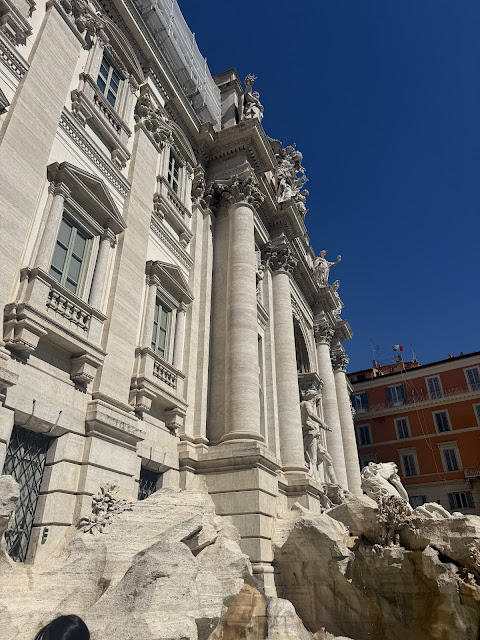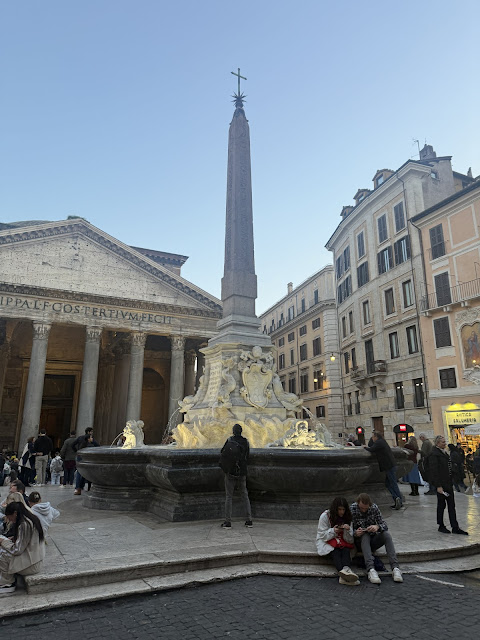Fountains of Italy
I'm not sure why fountains feel so magical, especially beautiful ancient fountains like the ones you'll find in Italy. Perhaps it's the idea of throwing a coin into a fountain after making a wish. Movies have been made surrounding this hopeful belief. Many people make time in their trip to Rome to visit the Trevi Fountain and throw a coin into the fountain, counting on the tradition that such an act would assure a return trip to Italy someday. Or perhaps it's the hope and gratitude that the people must have felt to have clean drinking water in past centuries when the fountains began delivering clean drinking water to the people. Whatever the reason, I am also mesmerized by fountains and make a point of finding and photographing them when I am in the vicinity of one of these beautiful monuments of water. Here are some of the fountains that I have visited in Italy.
Rome
There are many fountains in Rome. There is also at least one phantom fountain in Rome - namely, the Fountain of Love from the movie "When In Rome." I did visit the location of where the fountain was placed for the movie, and I sure wish I could have visited the actual fountain while it was still there.
Trevi Fountain
Definitely the most famous fountain in Italy, and perhaps in the entire world, is the Trevi Fountain in the heart of Rome. The Trevi Fountain is at the end of the ancient Aqua Virgo aqueduct and was at first a simple fountain built in 19 BC. The current fountain was not completed until 1762. The tradition of throwing a coin with your right hand over your left shoulder into the fountain to ensure a return trip to Rome is said to have ancient origins, with the additional superstition that throwing two coins will ensure love, and throwing three coins will ensure marriage. I've seen 3 movies that feature the Trevi Fountain: La Dolce Vita, Three Coins in the Fountain, and Roman Holiday. Incidentally, you can go underneath the Trevi District to see the waters of the aqueduct up close. I was misled into believing that this underground tour was actually under the Trevi Fountain -- it is not, but it is water that drained from the Trevi Fountain and one end of the underground area is in the Trevi District. It is worth the 4 euro to visit and is relatively easy to get a ticket.

.JPG) |
| The Trevi Fountain in 2025 |
.JPG) |
| Oceanus is the Greek Titan God of the Sea |
.JPG) |
| My daughter and I at the Trevi Fountain in 2025 |
Fontana dei Quattro Fiumi
The Fountain of the Four Rivers is one of three fountains in Piazza Navona. It was designed in 1651 by Gian Lorenzo Bernini. The Four Rivers represented by the fountain are the Nile, the Danube, the Ganges, and the Rio de la Plata.
.JPG) |
| This sculpture represents the River Ganges |
.JPG) |
| This sculpture represents the Danube |
.JPG) |
| This sculpture represents the Nile |
.JPG) |
| This sculpture represents River de la Plata |
.JPG) |
| The horses, created by Bernini, represents the connection between Europe and the Americas |
Fontana del Moro
The Fountain of the Moor is located at the southern end of Piazza Navona. It is one of three fountains in the plaza. It was designed by both Porta and Bernini. The central figure in the fountain is a Moor, or African, wrestling with a dolphin. He is surrounded by four tritons. The fountain was originally built in 1570 with water from the Virgin Aqueduct.
Fontana del Nettuno
The Fountain of Neptune is one of the three fountains in Piazza Navona. It is at the north end of the plaza. The basin of the fountain was built in 1574 and the sculptures were added in 1878. It was designed by Giacomo Della Porta.
Fountain of the Four Lions
The Fountain of the Four Lions, or Fontana dei Leoni is located in the center of Piazza del Popolo in Rome. I enjoyed that the fountain itself wasn't roped or fenced off. People were sitting on the steps of the fountain, walking across the fountain, although certainly not inside the basin bowls, which are, in fact, guarded by fences. The Flaminio Obelisk, which stands in the middle of the fountain and was brought to Rome from Egypt, was erected in 1589. The fountain was designed and built around the obelisk and completed in 1828. Its most recent renovation was completed in 2015.
.JPEG) |
| The Fountain of the Four Lions in 2025 |
.JPEG) |
| Flaminio Obelisk in the middle of the Fountain of the Four Lions, in 2025 |
Fontana del Nettuno, or Fountain of Neptune
While at the Piazza del Popolo, don't miss the Fountain of Neptune located on the west side of the square. There are other fountains of the same name - the Fountain of Neptune on Piazza Navona, for instance. This particular fountain was completed in 1823. The fountain was under construction when we visited Piazza del Popolo in 2025.
 |
| 2025 |
Fontana dei Tritoni, or Fountain of the Tritons
The Fountain of the Tritons is located in the vicinity of the Temple of Hercules Victor and the Mouth of Truth, which is housed inside the Basilica di Santa Maria in Cosmedin. The fountain was built in 1715. It is not to be confused with the Triton Fountain in the Palazzo Barberini. This particular fountain was designed by Carlo Bizzaccheri.
 |
| Fontana dei Tritoni in 2025 |
 |
| This photo of the Fountain of the Tritons includes in the background the Basilica de Santa Maria in Cosmedin, which houses the Mouth of Truth. |
.png) |
| The location of the Fountain of the Tritons near the Temple of Hercules Victor |
The Barcaccia Fountain, or Fontana della Barcaccia (Fountain of the Boat)
The Barcaccia Fountain is in Piazza di Spagna, at the foot of the Spanish Steps. It was among the fountains built from the Virgin Aqueduct, and since there was low water pressure, the fountain was designed to appear as a boat submerged in water and was originally level with the ground. It gives the impression that the boat is sinking. It was completed in 1629 and was designed by Pietro Bernini. It's possible that it was completed by Gian Lorenzo Bernini because his father Pietro died in 1629. It was built as a result of a Papal project to build fountains in every major public square in Rome.
Fontana di Piazza Colonna
The fountain in Piazza Colonna is another fountain originating from the Virgin Aqueduct that was built as part of the Papal project to construct fountains in every major public square. It was designed by Giacomo Della Porta and was completed in 1577. Like the other fountains built at this time it ran purely by gravity. Its purpose was to bring clean drinking water to the people of Rome.
.JPG) |
| There are 16 lion heads around the basin of the fountain |
.JPG) |
| The Column of Marcus Aurelius next to the Fountain in Piazza Colonna |
Fontana del Pantheon, the Fountain of the Pantheon
In the middle of Piazza della Rotonda, directly in front of the Pantheon, is the beautiful fountain designed by Giacomo Della Porta. He designed several other fountains throughout Rome. It was built in 1575. It was redesigned in 1711 and the Macuteo Obelisk was added to the center of the fountain. In 1886 the original marble statues of the fountain were removed and placed in the Museum of Rome, and duplicates were placed on the fountain. These photos were taken in 2025 during our visit to Rome.
.JPG) |
| The Pantheon is the perfect backdrop for this fountain |
.JPG) |
| As it began to get dark, the lights of the fountain turned on |
.JPG) |
| The Pantheon Obelisk, or Macuteo Obelisk, standing in the center |
.png) |
| The Fontana del Pantheon is a close walk from the Trevi Fountain and the Fontana di Piazza Colonna |
Triton Fountain in Piazza Barberini
Not to be confused with the Fountain of the Tritons near the Mouth of Truth, this fountain was created by Gian Lorenzo Bernini in 1643.
.JPG)
.JPG)
.JPG)
.JPG)
.JPG)
.JPG)
.JPG)
.JPG)
.JPEG)
.JPEG)



.png)
.JPG)
.JPG)
.JPG)
.JPG)
.JPG)
.png)

.JPG)
.JPG)
.JPG)
.JPG)

.JPG)
.JPG)
.JPG)
.JPG)
.JPG)
.JPG)
.JPG)
.JPG)
.JPG)
.JPG)
.JPG)
.JPG)
.JPG)
.JPG)
.JPG)
.JPG)
.JPG)
.JPG)
.JPG)
.JPG)
.JPG)
.JPG)
.JPG)
.JPG)
.JPG)
.JPG)
.JPG)
.JPG)
.JPG)
.JPG)
.JPG)
.JPG)
.JPG)
.JPG)
.JPG)
.JPG)
.JPG)
.JPG)
.JPEG)
.JPEG)
.JPEG)
.JPEG)

.JPG)
.JPG)
.png)
.JPG)
.JPG)
.JPG)
.JPG)

.JPG)
.JPG)


No comments:
Post a Comment